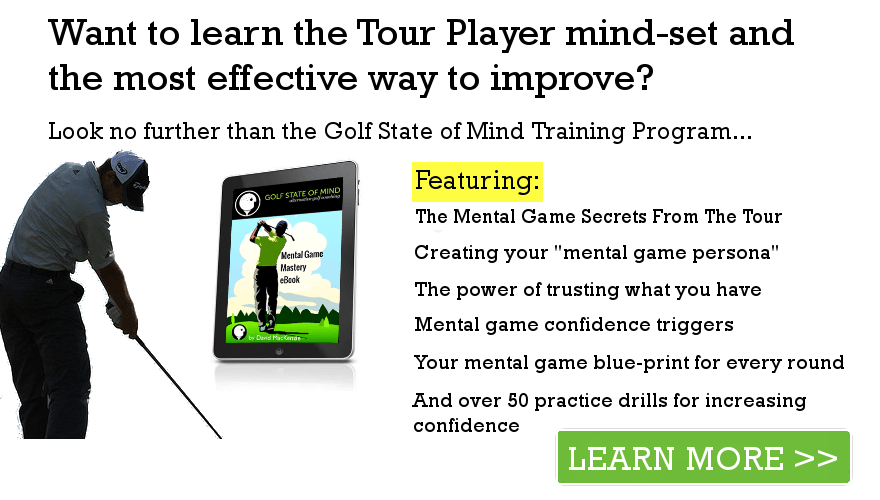All the thinking you need to do on the golf course can be done in the 30 seconds before the golf shot. The rest of the time, you can turn off your golf brain, and just relax.
I’m going to show exactly what this thinking needs to be. The Tour player thinks in the optimal way about each golf shot – they need to make every shot count. The following “process” is right out of the play book of the Tour player. Follow this and you’re on your way to your best golf…
Before every golf shot, I want you to ask yourself 2 basic questions:
1. What is my strategy?
2. Where is my target?
How to choose your target
Ben Hogan said that he only hit about 3-4 shots per round that came off exactly how he visualized them. The rest were good misses. Golf is a game of percentages and misses, and we have to factor that in to every shot. Even the Tour players miss 1/3 fairways and greens, but their misses are usually on the correct side of the trouble that can potentially lead to big numbers. Those who miss best win most. Point being, we all miss our desired target (a lot of the time, even the pros), it really comes down to how good our misses are.
Where is the “Good Miss”?
Ask yourself this question: “Where is the most ideal spot for this ball to land? But If I miss this target by 10 yards where is the best spot for this miss?”
Determine these spots and make your new target halfway between them.
If we take an example of water being short-right of the green and the pin is cut short right, then clearly is it better to pick a landing spot on the back/left quadrant on the green, giving us the largest margin for error and the most green to work with if we miss the green. This sounds obvious but it’s amazing how many good players don’t think about (inevitable) misses and just aim at the pin or center of the fairway. This is an integral part of the thought process of the top players (called a “conservative-aggressive strategy). They are not thinking or swinging any less aggressively, but by allowing for a miss (which even for the tour pros happens 1 in every 3 shots if you look at the Greens In Reg stats), they avoid bigger numbers and save valuable strokes per round.
Once you have decided on your target, find a spot on the horizon in line with it (e.g. tree branch, spot where a tree meets the sky etc). Be very decisive and have it clear in your mind.
Now you’ve decided on your more conservative target, let’s account for anything that might affect how the ball gets there.
Make allowances for your lie
If you’re in the light rough the ball is going to release more when it hits the green vs being on tight fairway. If you’re in heavier rough the ball isn’t going to fly as far through the air, but will release further when it hits the green. Is the ball on an up-slope or down-slope? Adjust your club selection to allow for this.
Is the ball above or below your feet? This will affect your starting target.
Assess the wind
Hold a pinch of grass and let go of it (don’t throw it in the air) to see the wind direction and how strong it is. This is one of those things that will come with experience, but you’ll start to notice winds in terms of “clubs”. E.g. “That wind is going to hurt by one club”, so we’ll take a 4 iron instead of a 5.
Use this information to adjust the “starting target” i.e. where the ball must start to get to it’s final target. Is this a one club wind blowing left to right? If so, then my target will need to be adjusted 10 yards to the left and you’ll need to take one more club.
When you’ve gone through this part of the process you’ll have a target that you know is the right one and one that you can commit to, which will give you the extra confidence to swing aggressively at the target.
Stayed tuned for the next step in the process: “How To Visualize and Feel golf shots and trust your subconscious”.
